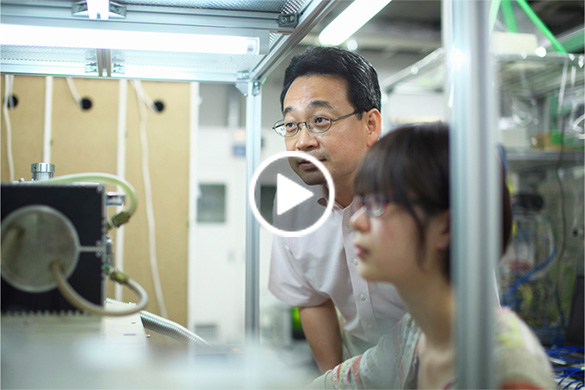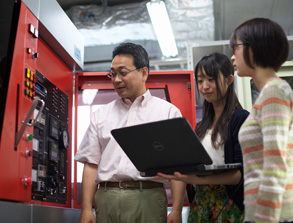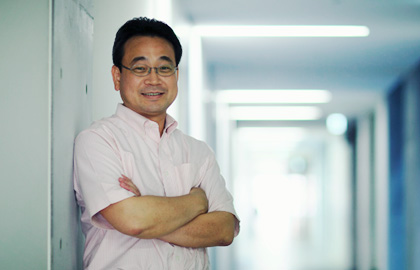-

-
Waste not, want not. This could well be the motto of Professor Tsutomu Iida. Iida is a man with a plan—an ambitious plan to harness waste heat on a global scale to protect the planet. Moreover, he is intent on generating results in the not-too-distant future.
"My research focuses on solid-state thermal-to-electric energy conversion technology," Iida says. "Our overarching mission is to create electricity from waste heat to help to reduce carbon dioxide emissions to minimize the greenhouse effect," he explains.
Put simply, Iida and his team are working to create something using essentially hot air. Right now, Iida and his research are at the vanguard of turning waste heat into electricity.
-
If all goes according to plan, Iida hopes to leverage the advanced technology he has developed to help mankind and the environment by cutting CO2 emissions and curbing global warming. Iida says the arithmetic is straightforward: Converting 10% of this loss into electricity would translate into 10% less fossil fuels being consumed.
"Today, more than 70% of primary source energy is waste heat. Imagine that—70% of the heat from vehicles is simply lost. We want to change that," he says.
-

-


-
Iida's research focuses on what at a glance seems like modern-day alchemy: making something from ostensibly nothing. In this case, this means generating electricity from waste heat. The research itself hinges on the thermoelectric effect—using differences in temperature to create electric voltage.
Like many, Iida has a passion for progress. However, his is one qualified by an approach that it must not harm the environment. If his approach to science had a second pillar, then it would be akin to the philosophy underpinning the Hippocratic Oath to "do no harm."
"Usually in science the priority is placed on performance, but I am committed to developing materials that are environmentally benign," Iida says.
The method Iida is honing has been around for a while. Indeed, it was pioneered and used to successfully power satellites into the depths of space beyond where solar power was a viable power source. Yet, while there have been a number of materials that have been efficient thermoelectric media, many contain toxic, harmful or problematic substances such as lead.
It was Iida's commitment to benign solutions that proved both the biggest hurdle to his developing a workable thermoelectric material and also fueled his greatest achievement. This approach and his expertise in materials led him to pursue changing waste heat into electricity using magnesium silicide (Mg2Si). Iida points out that the material has a number of things going for it: it is non-toxic, abundant and comparatively inexpensive—especially relative to the more toxic alternatives. In addition, it is light, which lends itself to automotive applications.
Still, there was a problem.
"Mg2Si had been known for a long time. The reason that it was not used until we developed a way to do it is because the boiling temperature of magnesium is lower than the temperature for synthesizing the crystals, so the magnesium would turn into gas," Iida explains.
-
This was the key technological hurdle: how to synthesize magnesium into a stable crystal for use. After immense effort, Iida overcame this through an all-molten synthesis process that resulted in a more durable Mg2Si less prone to oxidation. This breakthrough paved the way for refinements in efficiency. With a viable prototype now in hand, Iida says that commercialization is just around the corner.
"Thermoelectric power is a dynamic field. Things move quickly. But right now the materials we have developed at TUS are the top in the world in terms of efficiency and durability," says Iida.
-


-

-
Seeking the greatest scope for the application of thermoelectric power generators, Iida focused on automobiles. The number of vehicles worldwide is only poised to grow, with 100 million combustion engine vehicles forecast to be on the planet’s roads in 2020.
Iida's research has him ahead of the curve. Iida explains that waste heat is a vast, untapped resource, pointing to a study by a leading petroleum producer that predicts that unused heat resources will make up around 20% of primary energy sources circa 2060.
Currently, the European Union (EU) is in pole position as it moves to stiffen CO2 emissions regulations greatly in 2015 and then further in 2020.
"As a result, the EU has launched a project working to integrate these systems into vehicles. Because we in Japan excel in materials we are working with them on this development," Iida explains.
In Iida's lab, energy is truly in the air as Iida and his team are on the cusp of seeing their hard work begin to yield benefits on a global scale.
Professor Iida, a former Fellowship of the Japan Society for the Promotion of Science and a Visiting research scholar of the Volkswagen Foundation, joined TUS in 1997. Since then, at the Faculty of Industrial Science and Technology has been focussed in the research of Semiconductor Energy Materials and ‘Environmentally Friendly’ Semiconductor Materials.
Iida-lab. > https://www.tus-iidalab.com/



